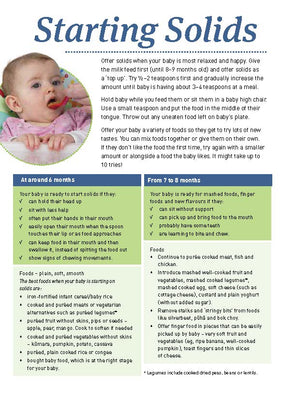Starting Solids - HE6014

Information on infant feeding, nutrition, and solid foods.
The full resource:
Offer solids when your baby is most relaxed and happy. Give the milk feed first (until 8–9 months old) and offer solids as a ‘top up’. Try 1⁄2–2 teaspoons first and gradually increase the amount until baby is having about 3–4 teaspoons at a meal.
Hold baby while you feed them or sit them in a baby high chair. Use a small teaspoon and put the food in the middle of their tongue. Throw out any uneaten food left on baby’s plate.
Offer your baby a variety of foods so they get to try lots of new tastes. You can mix foods together or give them on their own. If they don’t like the food the first time, try again with a smaller amount or alongside a food the baby likes. It might take up to 10 tries!
At around 6 months
Your baby is ready to start solids if they:
- can hold their head up
- sit with less help
- often put their hands in their mouth
- easily open their mouth when the spoon touches their lip or as food approaches
- can keep food in their mouth and then swallow it, instead of spitting the food out
- show signs of chewing movements.
Foods – plain, soft, smooth
The best foods when your baby is starting on solids are:
- iron-fortified infant cereal/baby rice
- cooked and puréed meats or vegetarian alternatives such as puréed legumes*
- puréed fruit without skins, pips or seeds – apple, pear, mango. Cook to soften if needed.
- cooked and puréed vegetables without skins − kūmara, pumpkin, potato, cassava
- puréed, plain cooked rice or congee
- bought baby food, which is at the right stage for your baby.
* Legumes include cooked dried peas, beans or lentils.
From 7 to 8 months
Your baby is ready for mashed foods, finger foods and new flavours if they:
- can sit without support
- can pick up and bring food to the mouth
- probably have some teeth
- are learning to bite and chew.
Foods
- Continue to purée cooked meat, fish and chicken.
- Introduce mashed well-cooked fruit and vegetables, mashed cooked legumes*, mashed cooked egg, soft cheese (such as cottage cheese), custard and plain yoghurt (without added sugar).
- Remove stalks and ‘stringy bits’ from foods like silverbeet, pūhā and bok choy.
- Offer finger food in pieces that can be easily picked up by baby – very soft fruit and vegetables (eg, ripe banana, well- cooked pumpkin), toast fingers and thin slices of cheese.
* Legumes include cooked dried peas, beans or lentils.
Between 8 and 12 months
Your baby is ready for more textures and lumpy foods if they:
- are learning to crawl and may pull themselves up to stand
- can bite well and can chew soft lumps
- are interested in a range of foods and textures
- need some help to eat.
Foods
- Try mashed vegetables mixed with minced or finely chopped tender cooked meat, chicken, kai moana, egg or slightly mashed cooked legumes*. You could also add chopped up noodles or pasta or whole rice.
- Add chopped soft fruit to yoghurt or custard.
- Offer breakfast cereal – porridge, wheat biscuits and infant muesli.
- Introduce slightly firmer finger foods such as:
- soft ripe fruit or soft cooked vegetables such as kiwifruit or kūmara
- finely grated raw carrot and apple
- toast fingers
- puffed crispbread.
* Legumes include cooked dried peas, beans or lentils.
From 12 months
Your toddler is ready for many different spoon and finger foods if they:
- can easily use their hands and fingers to feed themselves
- can hold a cup with two hands and drink from it
- has molar teeth starting to appear (the larger teeth at the back of the mouth, which are used to chew and grind food)
- can bite through a variety of different foods and chew well.
Foods
- Breads – pita, rēwena, chapatti, buns, rolls – cut to a size that your toddler can easily hold and eat.
- Small sandwiches with thinly sliced fillings or a thin layer of easy-to-spread ingredients (for example, yeast-based spread).
- Soft pieces of vegetables and fruit, including new ones (cook or finely grate if raw).
- Finely chopped salad vegetables – lettuce, cucumber.
- Yoghurt and slices of cheese.
- Tender, finely chopped lean meat, chicken, seafood and egg.
- Soft, slightly mashed legumes*.
- A variety of cereals (remove very hard foods like whole nuts or hard dried fruit).
* Legumes include cooked dried peas, beans or lentils.
Choking and foods to avoid
Babies and young children can choke quite easily, so feed them only while they are seated and always stay with them while they eat.
Some foods are more likely to cause choking and should be avoided (whole nuts and large seeds), or altered (grated, cooked, finely chopped, mashed, skins removed) before giving them to your baby or young child.
Allergies
Try new foods one at a time every 2–4 days. If you suspect an allergy, or have a strong family history of allergy, talk to your doctor.
For more information
Ask your health professional for a copy of Eating for Healthy Babies and Toddlers, Code HE1521, or see your Well Child Tamariki Ora Health Book